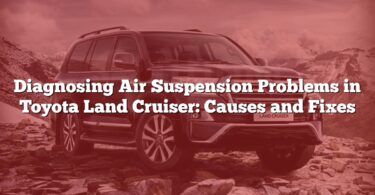If you’ve noticed a strong gasoline smell coming from your Toyota Land Cruiser’s exhaust, it’s more than just an inconvenience—it could signal a range of underlying issues. From minor leaks to critical engine malfunctions, understanding the causes and addressing them promptly is key to keeping your vehicle safe and running efficiently. This guide breaks down 36 potential reasons for the problem, along with clear, actionable solutions to get your Land Cruiser back in top shape.
Guide to Diagnosing and Fixing Gasoline Smells in a Toyota Land Cruiser: 36 Problems and Solutions
| N° | Problem/Cause | Solution |
|---|---|---|
| 1 | Rich air-fuel mixture | Inspect and adjust the air-fuel ratio; reprogram ECU if necessary. |
| 2 | Faulty oxygen sensor | Replace the faulty oxygen sensor. |
| 3 | Leaking fuel injectors | Repair or replace the leaking fuel injectors. |
| 4 | Damaged fuel pressure regulator | Replace the damaged fuel pressure regulator. |
| 5 | Clogged air filter | Replace the clogged air filter. |
| 6 | Bad mass airflow (MAF) sensor | Clean or replace the MAF sensor. |
| 7 | Faulty engine coolant temperature sensor | Replace the faulty coolant temperature sensor. |
| 8 | Malfunctioning catalytic converter | Replace the malfunctioning catalytic converter. |
| 9 | Leaking exhaust system | Identify and seal leaks in the exhaust system. |
| 10 | Fuel line leak or damage | Repair or replace the damaged fuel line. |
| 11 | Incomplete combustion in cylinders | Check engine tuning and ensure proper combustion. |
| 12 | Dirty or malfunctioning spark plugs | Clean or replace the spark plugs. |
| 13 | Worn ignition coils | Replace the worn ignition coils. |
| 14 | Cracked or damaged intake manifold | Repair or replace the intake manifold. |
| 15 | ECU programming or sensor calibration errors | Reprogram the ECU and calibrate the sensors. |
| 16 | Stuck open purge valve in the EVAP system | Replace the stuck purge valve. |
| 17 | Leaking EVAP system components | Inspect and repair or replace leaking EVAP components. |
| 18 | Fuel tank venting issues | Inspect and repair the fuel tank venting system. |
| 19 | Faulty fuel pump overpressurizing system | Replace or repair the fuel pump. |
| 20 | Engine timing issues | Adjust engine timing to manufacturer specifications. |
| 21 | Damaged exhaust manifold gasket | Replace the damaged gasket. |
| 22 | Improperly installed or modified exhaust system | Reinstall or modify the exhaust system correctly. |
| 23 | Old or contaminated fuel | Drain and refill with fresh, high-quality fuel. |
| 24 | Engine misfire | Diagnose and repair the cause of the misfire. |
| 25 | High carbon build-up in the combustion chamber | Use a fuel system cleaner or manually clean carbon deposits. |
| 26 | Vacuum leaks | Locate and seal all vacuum leaks. |
| 27 | Cracked or broken fuel vapor hoses | Replace cracked or broken fuel vapor hoses. |
| 28 | Damaged or worn piston rings | Rebuild or replace the engine pistons and rings. |
| 29 | Leaking head gasket | Replace the leaking head gasket. |
| 30 | Excessive use of fuel additives | Avoid overusing fuel additives; flush and refill with fresh fuel if needed. |
| 31 | Spilled gasoline | Clean the affected area thoroughly and allow time for the fumes to dissipate. |
| 32 | Loose or faulty gas cap | Tighten or replace the gas cap. |
| 33 | Leaking oil | Locate and repair oil leaks; clean any spilled oil. |
| 34 | Leaking or worn-out fuel tank | Repair or replace the fuel tank. |
| 35 | Loose spark plugs | Tighten or replace the spark plugs. |
| 36 | Exhaust leaks between the engine and catalytic converter | Repair or replace damaged sections of the exhaust system. |
Detailed Guide : Causes and Solutions for Gasoline Smell in a Toyota Land Cruiser’s Exhaust
1. Rich Air-Fuel Mixture
- Reason: A rich air-fuel mixture occurs when there is too much fuel compared to air in the engine, leading to incomplete combustion and excess unburned fuel in the exhaust.
- Solution: Adjust the air-fuel ratio using diagnostic tools to ensure the engine receives the correct mixture. If the problem persists, inspect the fuel injection system for blockages or malfunctions.
2. Faulty Oxygen Sensor
- Reason: A malfunctioning oxygen sensor provides incorrect feedback to the engine control unit (ECU), causing inefficient combustion and unburned fuel in the exhaust.
- Solution: Replace the defective oxygen sensor with a new one. Ensure the replacement matches your vehicle’s specifications.
3. Clogged Air Filter
- Reason: A clogged air filter restricts airflow to the engine, disrupting the air-fuel balance and leading to excess fuel in the exhaust.
- Solution: Remove the air filter and inspect it. If it’s dirty or damaged, replace it. If it’s reusable, clean it with compressed air or water as specified.
4. Malfunctioning Fuel Injector
- Reason: A faulty fuel injector may spray too much or too little fuel, causing incomplete combustion.
- Solution: Inspect the fuel injectors for leaks or clogs. Replace damaged injectors or clean them using a specialized fuel injector cleaner.
5. Leaking Fuel Line
- Reason: Fuel line leaks can cause fuel vapors to escape, leading to a gasoline smell in the exhaust.
- Solution: Locate the leak in the fuel line. Replace the damaged section or repair minor cracks using appropriate sealants. Always ensure the connections are secure.
6. Damaged Fuel Pressure Regulator
- Reason: A faulty fuel pressure regulator can cause excessive fuel delivery, resulting in unburned gasoline in the exhaust.
- Solution: Test the fuel pressure regulator with a fuel pressure gauge. Replace it if it doesn’t maintain the correct pressure.
7. Faulty Mass Air Flow (MAF) Sensor
- Reason: A malfunctioning MAF sensor sends inaccurate airflow data to the ECU, leading to an improper air-fuel ratio.
- Solution: Clean the MAF sensor using an appropriate cleaner or replace it if cleaning doesn’t resolve the issue.
8. Defective Spark Plugs
- Reason: Worn or defective spark plugs fail to ignite the air-fuel mixture properly, resulting in unburned fuel in the exhaust.
- Solution: Remove the spark plugs and inspect them. Replace any that are damaged or excessively worn.
9. Worn Ignition Coils
- Reason: Faulty ignition coils prevent proper spark generation, leading to incomplete combustion.
- Solution: Test the ignition coils using an ohmmeter. Replace any coils that don’t meet the resistance specifications.
10. Leaking Exhaust Manifold
- Reason: Cracks or leaks in the exhaust manifold allow unburned gases to escape before they reach the catalytic converter.
- Solution: Inspect the manifold for visible cracks or leaks. Seal small cracks with high-temperature epoxy or replace the manifold if necessary.
11. Catalytic Converter Malfunction
- Reason: A malfunctioning catalytic converter fails to convert unburned fuel into less harmful gases.
- Solution: Test the catalytic converter using an exhaust gas analyzer. Replace it if it’s clogged or damaged.
12. Incomplete Combustion
- Reason: Incomplete combustion occurs when the engine doesn’t fully burn the fuel, often due to ignition or fuel system issues.
- Solution: Check the fuel injectors, spark plugs, and ignition timing. Address any irregularities.
13. Leaking EVAP System
- Reason: The EVAP system prevents fuel vapors from escaping into the atmosphere. A leak causes the vapors to enter the exhaust.
- Solution: Conduct a smoke test to identify leaks in the EVAP system. Replace or repair faulty components.
14. Defective Engine Control Unit (ECU)
- Reason: A malfunctioning ECU mismanages fuel delivery, leading to inefficient combustion.
- Solution: Reprogram or replace the ECU using a professional diagnostic tool.
15. Vacuum Leak
- Reason: A vacuum leak introduces excess air into the engine, disrupting combustion.
- Solution: Use a smoke machine or soapy water to identify the leak. Seal it with appropriate gaskets or adhesives.
16. Cracked or Damaged Fuel Tank
- Reason: A damaged fuel tank leaks gasoline, causing fumes to escape into the exhaust system.
- Solution: Inspect the tank for cracks. Seal minor cracks with epoxy or replace the tank if the damage is extensive.
17. Leaking Fuel Injector Seals
- Reason: Damaged seals allow fuel to leak and mix with the exhaust gases.
- Solution: Replace the seals and ensure proper installation to prevent future leaks.
18. Excessive Carbon Build-Up
- Reason: Carbon deposits disrupt combustion and lead to unburned fuel in the exhaust.
- Solution: Clean the combustion chamber and intake system using a carbon-cleaning solution.
19. Faulty Crankshaft Position Sensor
- Reason: A malfunctioning sensor disrupts engine timing, leading to incomplete combustion.
- Solution: Test the sensor with a multimeter. Replace it if the readings are outside the specified range.
20. Dirty or Damaged Throttle Body
- Reason: A dirty throttle body restricts airflow, leading to an imbalanced air-fuel mixture.
- Solution: Clean the throttle body using a throttle body cleaner. Replace it if damaged.
21. Fuel Pump Malfunction
- Reason: A faulty fuel pump delivers insufficient or excessive fuel, affecting combustion.
- Solution: Test the fuel pump’s pressure. Replace it if it doesn’t meet specifications.
22. Cold Start Enrichment Issue
- Reason: Excess fuel during a cold start can lead to unburned fuel in the exhaust.
- Solution: Adjust the cold start settings via the ECU. Check related sensors.
23. Improperly Installed Exhaust Components
- Reason: Misaligned or damaged components cause leaks, allowing gasoline fumes to escape.
- Solution: Reinstall or replace misaligned or damaged exhaust parts.
24. Leaking EGR Valve
- Reason: A leaking EGR valve lets unburned gases escape into the exhaust.
- Solution: Repair or replace the EGR valve. Ensure it functions correctly.
25. Damaged or Worn Piston Rings
- Reason: Worn piston rings allow fuel and oil to mix, leading to incomplete combustion and unburned fuel in the exhaust.
- Solution: Rebuild or replace the piston rings. This requires disassembling the engine:
- Remove the cylinder head.
- Extract the pistons.
- Replace the worn piston rings with new ones.
- Reassemble the engine with proper torque specifications.
26. Blown Head Gasket
- Reason: A blown head gasket can cause fuel, oil, or coolant to mix and enter the combustion chamber, resulting in unburned fuel in the exhaust.
- Solution: Replace the head gasket:
- Remove the cylinder head.
- Inspect for warping or cracks.
- Replace the gasket and reinstall the cylinder head.
- Tighten bolts to the manufacturer’s torque specifications.
27. Damaged Intake Manifold Gasket
- Reason: A damaged intake manifold gasket allows unmetered air into the engine, disrupting the air-fuel ratio.
- Solution: Replace the intake manifold gasket:
- Remove the intake manifold.
- Clean the surfaces where the gasket seals.
- Install a new gasket and reassemble the manifold.
28. Overfilled Fuel Tank
- Reason: Overfilling the fuel tank causes excess fuel to escape through the EVAP system and enter the exhaust.
- Solution: Drain the excess fuel to the proper level:
- Use a siphon pump to remove the extra fuel.
- Refill to the recommended level, ensuring you don’t overfill.
29. Faulty PCV (Positive Crankcase Ventilation) Valve
- Reason: A malfunctioning PCV valve can cause fuel vapors to mix with exhaust gases.
- Solution: Replace the PCV valve:
- Locate the valve (usually on the valve cover).
- Remove and inspect it for clogs or damage.
- Install a new valve if necessary.
30. Contaminated Fuel
- Reason: Contaminated fuel can disrupt combustion, resulting in unburned fuel in the exhaust.
- Solution: Drain the fuel tank and replace the fuel:
- Remove the contaminated fuel using a siphon pump.
- Refill the tank with clean, high-quality fuel.
- Replace the fuel filter to avoid further contamination.
31. Excessive Oil Consumption
- Reason: Excess oil burning in the engine can mix with fuel and produce a strong gasoline odor in the exhaust.
- Solution: Address the oil consumption issue:
- Inspect for oil leaks around gaskets and seals.
- Replace any worn seals or gaskets.
- Check for worn piston rings and replace if necessary.
32. Spilled Gasoline During Refueling
- Reason: Gasoline spilled on the vehicle or around the fuel filler area during refueling can cause a persistent gasoline odor.
- Solution: Clean the spill:
- Wipe the affected area with a clean, absorbent cloth.
- Wash with soapy water and allow it to air dry.
- Ensure the gas cap is tightened securely.
33. Loose or Faulty Gas Cap
- Reason: A loose or damaged gas cap allows fuel vapors to escape and produce a gasoline smell.
- Solution: Tighten or replace the gas cap:
- Check the gas cap for cracks or wear.
- Replace it with a new, properly fitting cap if necessary.
34. Exhaust Leak
- Reason: A leak in the exhaust system allows unburned gases to escape before being fully processed by the catalytic converter.
- Solution: Locate and repair the leak:
- Inspect the exhaust system for visible cracks or rust.
- Seal small leaks with high-temperature epoxy or replace damaged sections.
35. Leaking Oil
- Reason: Oil leaking onto hot engine components can produce fumes that mix with the exhaust, causing a gasoline-like smell.
- Solution: Address the oil leak:
- Identify the source of the leak (e.g., valve cover gasket, oil pan).
- Replace the leaking component or gasket.
- Clean the engine to remove residual oil.
36. Loose Spark Plugs
- Reason: Loose spark plugs can cause fuel to escape the combustion chamber, resulting in unburned fuel in the exhaust.
- Solution: Tighten or replace the spark plugs:
- Remove the loose spark plugs and inspect them.
- Replace damaged plugs.
- Reinstall and tighten them to the recommended torque specifications.
Preventing Future Issues
To minimize the chances of gasoline smells in your Toyota Land Cruiser’s exhaust, regular maintenance and proper care are essential. Follow these step-by-step guidelines to prevent future issues:
- Perform Regular Inspections:
- Check the fuel system, including lines, injectors, and tank, for leaks or damage.
- Inspect the exhaust system for signs of corrosion or cracks.
- Examine gaskets and seals for wear and tear.
- Keep the Air and Fuel Systems Clean:
- Replace the air filter every 15,000–30,000 miles (or as recommended by your manufacturer).
- Use high-quality fuel to prevent contamination.
- Add fuel system cleaners periodically to remove carbon buildup.
- Maintain Engine Components:
- Replace spark plugs and ignition coils at regular intervals.
- Ensure the Mass Air Flow (MAF) and oxygen sensors are clean and functioning correctly.
- Schedule routine inspections of the catalytic converter and PCV valve.
- Monitor Engine Performance:
- Pay attention to warning lights on the dashboard, such as the “Check Engine” light.
- Listen for unusual sounds, such as tapping or hissing from the exhaust or engine.
- Address Problems Early:
- Fix any oil or fuel leaks immediately to prevent damage to other components.
- Tighten or replace loose components, such as gas caps or spark plugs, as soon as an issue is noticed.
- Follow the Maintenance Schedule:
- Adhere to your Toyota Land Cruiser’s recommended service intervals.
- Schedule professional diagnostics annually or as needed to catch potential issues early.
- Practice Safe Refueling:
- Avoid overfilling the fuel tank.
- Clean any spilled gasoline immediately to prevent residue buildup.
By following these preventive measures, you can extend the lifespan of your vehicle, reduce repair costs, and maintain a safer, more efficient driving experience. Regular care not only prevents gasoline smells but also ensures optimal vehicle performance.







